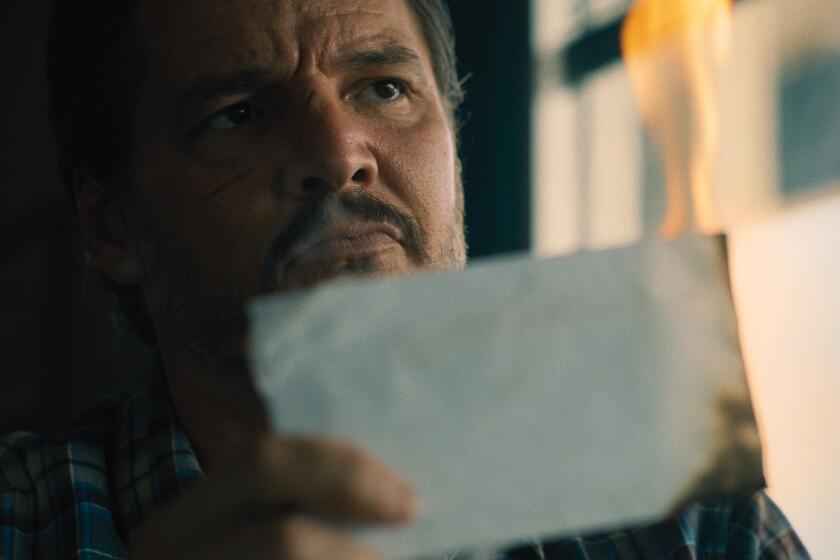In ‘American Hustle,’ the costumes are practically characters
- Share via
There’s a bright shot of star power in David O. Russell’s period film “American Hustle,” and it’s not just from its celebrated cast. Veteran designer Michael Wilkinson’s late-1970s costumes have something of a starring role of their own. Loosely based on the real-life Abscam FBI sting, “Hustle” lives in a gritty yet sophisticated East Coast world where the con artist characters have plenty of different looks for different occasions.
The sartorial tone had to be “just right,” says Wilkinson. “It’s an era that can look and feel like a cliché rather easily — that groovy, shagadelic look — so we worked hard to make sure that didn’t happen. David encouraged me to go very deep into the process. I loved the fact that these were characters inside characters, and how they presented themselves to the world was a large part of the script — that intrigued me from the start.”
Amy Adams’ silver-gray casino glitter gown, it looked very Halston. Jennifer Lawrence’s not so much.
Yes, we looked at a lot of designers of that period — Halston, Diane Von Furstenberg, Ferragamo, Christian Dior, YSL — all the greats. But the interesting thing about these two characters — and one of the great things about the script — you see lots of varied demographics. You have this fantastically sophisticated Manhattan scene where the edgy fashion-forward world is typified by amazing designers like Halston, but you also have Long Island, the world of Jennifer Lawrence’s character. She’s a bored, frustrated, upper-middle-class housewife who lives out in the sprawling suburbs, so that has its own whole aesthetic. When you see Amy and Jennifer in their gowns, you have Amy wearing that wonderfully streamlined, simple Halston, and then you have Jennifer Lawrence in a somewhat suburbanite dress.
Is David Russell’s style as hands-on in terms of costume as you would assume, given his intense connection to his characters?
David is incredibly involved. These characters come from deep within his incredible imagination, and he has given birth to them in a sense; they’re all very, very close to his heart. They’re so detailed and he cares about every aspect of them: what music they listen to, the houses they live in, how they dance, their accents, down to the clothes and how they present themselves to the world. It was a real costume cavalcade: Amy has at least 40, 50 changes; it’s just one costume after the other.
TIMELINE: The Academy Awards through the years
And what was so fun was that costume cavalcade was for the men too. Usually, it’s just the female stars.
The men’s clothes of this period, they have so much room for expression that has disappeared from men’s wardrobes today. I loved the way that Christian [Bale’s] character combines the stripes, the dots, the chevron and the herringbone, and he had this very personal way of dressing that was very expressive. Even Bradley [Cooper’s] character, you could see he was a man who was searching for a way to express himself, to find his identity and how he fit into the whole picture. He starts off with the ill-fitting polyester suits, but by the end when he comes under the spell of the romance of the hustle, he starts to buy cool sunglasses and a special leather jacket.
Why did you choose to have Amy’s dresses so low-cut? Was that something you chose from the start or did it evolve over time?
It was all part of her transformation. It went with the period where women were wearing much less undergarments — it just seemed like a great progression of where she was at and how confident she was feeling. Part of her hustle was to use her physical appeal, her English accent and her sophistication to manipulate situations to her advantage.
VIDEO: Highlights from the Envelope Screening Series
What was it like working with Amy Adams and Jennifer Lawrence in the costuming?
Amy was amazing. We had racks of clothes lined up in her fitting room, and she has a very intuitive response to clothes. She walks differently when she has different clothes on. She’s drawn to all the textures that her scene’s state of mind calls for. For Jennifer, rather than try on 50 different outfits, she kind of reaches for one thing on the rack and it feels right. And the fantastic thing about her character is we see she has almost a schizophrenic quality, two extremes: We see her mooning around the house in her oversized housedresses, muumuus and terry-cloth slippers, and then we see her dressed to kill when she’s out on the town with her husband and she’s poured herself into these rather outlandish evening ensembles that are too small for her.
More to Read
Only good movies
Get the Indie Focus newsletter, Mark Olsen's weekly guide to the world of cinema.
You may occasionally receive promotional content from the Los Angeles Times.








